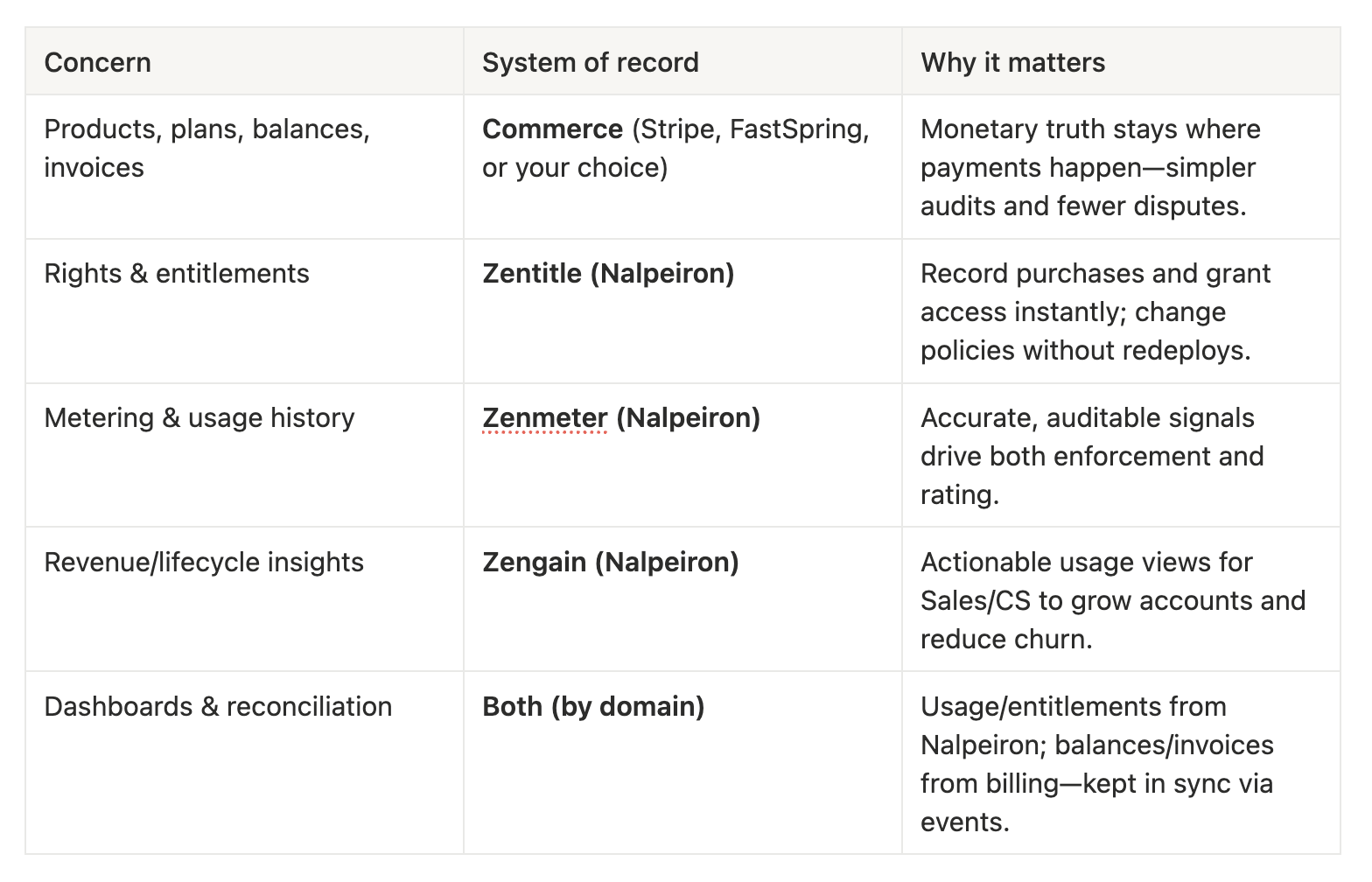4
-min read

Hybrid pricing is now standard: a predictable base subscription with usage-based components that scale as customers succeed. The real unlock isn’t the formula; it’s the architecture. Keep billing and balances in your commerce system—a robust billing system is essential for handling complex hybrid pricing requirements. Keep entitlements, runtime enforcement, and usage signals in your product/entitlement layer. That separation preserves speed, choice, and low risk as models evolve. Advanced cloud infrastructure is crucial for supporting scalable and flexible hybrid pricing models.
Nalpeiron fits this pattern: Zentitle governs rights and access; Zentitle Usage-Based Licensing meters consumption; Zengain equips revenue teams with actionable usage insights; and your commerce platform (Stripe, FastSpring, or others) owns money, balances, and invoices. This architecture is designed for allowing businesses to test and manage pricing models without extensive technical overhead. The two sides stay in sync—without hard-wiring billing logic into your app. This enables businesses to adapt and innovate their pricing strategies with minimal risk.
Hybrid pricing models offer flexibility in how customers pay, combining predictable fees with scalable usage charges.
This division keeps each system authoritative in its own domain so you can change models—or providers—without refactoring core code.
With Zentitle Usage-Based Licensing, you can meter by tenant, feature, seat, transaction, time, or data; apply thresholds or pools; and audit usage histories. These signals power both enforcement (what’s allowed) and rating (what gets billed).
By analyzing user behavior through these usage signals, you gain valuable insights that help optimize pricing strategies and adapt to customer needs.
Use native integrations for Stripe and FastSpring. For everything else—charge platforms, internal order systems, marketplaces—connect via APIs/Webhooks and workflow tools (e.g., Zapier). (n8n integration is documented as in progress.) You keep freedom of choice without brittle glue code.
This section explores common hybrid patterns that combine elements of the usage based model and subscription based approaches to meet diverse customer needs. Hybrid models are increasingly popular as they allow businesses to align pricing with customer usage while maintaining predictable revenue streams.
Platform fee + metered overage
Seats + pooled credits
Feature tiers + consumption add-ons
The freemium model is another effective strategy, where a free version with limited features is offered to attract users. This approach encourages users to upgrade to paid plans with additional features or capabilities, supporting customer acquisition and long-term growth.

Unlike traditional software, SaaS models offer subscription-based billing, dynamic entitlements, and operational flexibility. Traditional software typically requires upfront costs and static licenses, while SaaS enables ongoing updates and easier policy changes.
In the SaaS industry, customer experience and loyalty are the foundation of sustainable business growth. A well-crafted hybrid pricing model—combining the strengths of usage based pricing, subscription pricing, and consumption based pricing—can significantly boost customer satisfaction and foster long-term relationships.
Hybrid pricing models allow customers to pay a predictable recurring fee for core features, while also giving them the flexibility to scale usage or unlock additional features as their needs evolve. This approach not only delivers a predictable revenue stream for your SaaS business, but also empowers customers to control their costs and usage, reducing financial commitment anxiety and increasing perceived value.
For example, a SaaS company might offer a fixed fee for a base level of service, with usage based billing for additional API calls, data storage, or premium features. This lets different customer segments choose the pricing tier and usage level that best fits their needs—whether they’re just starting out or are high usage customers with fluctuating demands.
To maximize customer satisfaction and loyalty with hybrid pricing, focus on these best practices:
By implementing a hybrid pricing strategy that combines subscription models with usage based and consumption based billing, SaaS businesses can create a customer experience that is both predictable and adaptable. This not only increases customer satisfaction, but also builds customer loyalty—turning satisfied users into long-term advocates.
Ultimately, hybrid pricing models enable SaaS companies to align pricing with actual usage and customer value, providing customers with the flexibility they demand while ensuring a steady, predictable revenue stream. By focusing on customer needs and transparent communication, you can strengthen customer relationships, drive retention, and unlock new revenue streams for your SaaS business.
Hybrid pricing works best when your architecture matches your model. Keep balances and invoices in commerce. Keep access and enforcement in entitlements. Connect them with clean, observable events. With Nalpeiron, you can change pricing—and providers—on your timeline, preserving speed, agility, flexibility, and low risk.